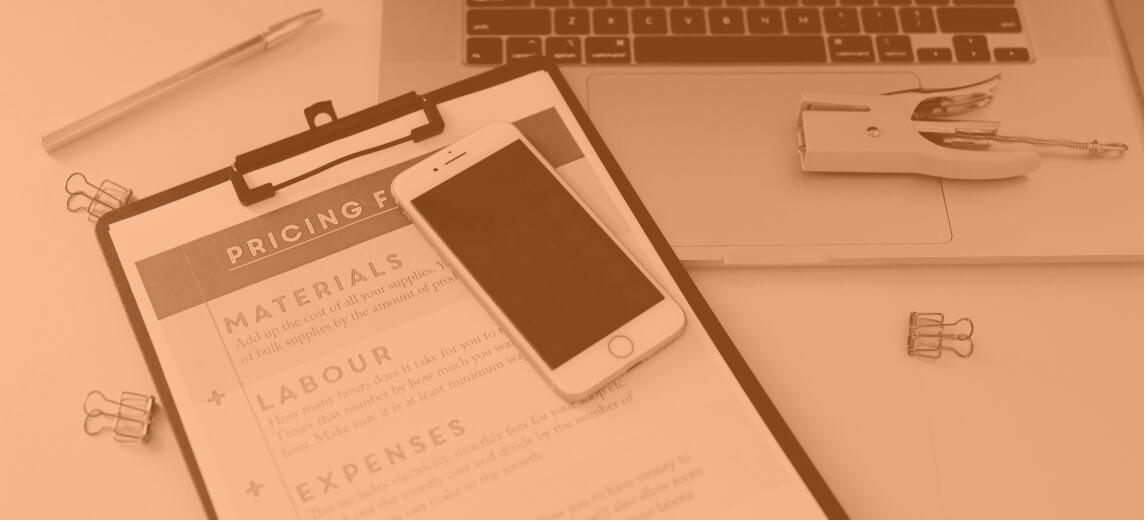
Setting the Selling Price for Your Products - Tips for Smart Start-Ups
Calculating the selling price for your products is hugely important if you want to start a business. After all, you are going to make a living selling products. The choices you make in pricing your products will help determine whether you will be eating dry bread, or lavish sandwiches.
There is no one formula you can use to calculate the selling price. So it's worth thinking about very carefully. We list 6 things to consider in determining your selling price.
1. Products and services: two different things
A butcher sells meat. An ICT consultant sells knowledge. Services and products are completely different things. It goes without saying that services and products are priced differently:
With services, you get paid primarily for your time and experience.
With products, other factors play a role in your pricing.
Despite the difference between products and services, all startups face costs and expenses.
And these tend to be much higher for merchants and retailers than for service providers.
To price your products, it is very wise to first calculate ‘how much cost you will incur yourself.’
Pro Tip
Enter the price of your products only once in CoManage. And use this on all your quotes and invoices.

2. Your point of sale costs money
The location where you will sell your products plays a big role in your expenditure calculation. And thus also in determining your selling price. There are roughly two options:
Offline in physical reality
Online via an online shop
Online and offline sales are often combined. The strength of a webshop is mainly that you can reach a wider audience. And that your store is open 24/7.
Costs for your offline outlet
These costs can be estimated correctly in advance.
Rent or purchase a storefront and/or storage space
Furnishing of the store
Utilities: water, gas, electricity
Etc.
Costs for your online outlet
You can also calculate these costs perfectly in advance. These include:
Costs for the design and development of your webshop
Shipping costs for your packages
Packaging to send your goods
Etc.
All in all, that's a lot of money. Money that you at least want to earn back. And let's face it: what you'd like to earn on anyway.
If you're going to sell products, don't forget to calculate your point-of-sale costs. It's best to do this before you set your selling price.
3. Making your own products costs money
Either you sell products made by others, or you produce and sell your own products. In the latter case, there is very little chance that you will be fully responsible for the production chain. And so you will also have to cough up money for raw materials, assembly, or production.
Example: making and selling your own products
Gerda starts her own fashion label for children.
Her side job became very profitable after a while. Therefore, she decided to start her own fashion label. Although she makes the unique garments entirely herself, she still relies on suppliers for her fabrics. So she does not make her raw materials herself, but buys them from third parties.
She does process these herself into a finished product for her customers. However, a large part of her turnover has to be invested in buying new fabrics every season.
So, if you are going to make and sell your own products, there are a number of additional expenses to take into account.
How much does it cost to develop your product (research & development)?
How much does it cost to buy your 'basic ingredients'?
How much does it cost to turn these 'basic ingredients' into a marketable final product?
An example to explain the importance of these questions:
Example: price to make and sell your own products
Dirk has a business idea: The Rainbow Detector.
The idea is to sell a device that you place outside in your garden. When a rainbow appears, you get a notification on your smartphone. So you don't have to peer through the window all the time to know if there is a rainbow.
Needless to say, this is a very bad idea. No one is waiting for this. Yet Dirk persists in anger and is blind to good advice.
In order to sell his device, he must first develop it. He cannot do this entirely himself and must hire the expertise of third parties. He also has little touch with electronics and, in addition, he also has no devices to produce the parts of his Rainbow Detector.
For all these things, however, he has to pay. The entire research and development phase costs him 15,000 euros.
Once his product is on point, he also pays a production cost of 65 euros per device.
4. Buying products to resell also costs money
Of course you knew this, but we would like to point out some interesting things that can lower your purchase price. It depends of course on your supplier, but it is good to know that these options exist.
Volume purchase can bring down your purchase price
The simple principle: the more you buy, the less you pay (per unit) can dramatically lower your purchase price. And thus increase your potential profit margin.
Just be sure you can resell the purchased volume yourself. If not, you are left with a potential threat to the financial health of your start-up.
Consignment: pay as you sell
This simple revenue model amounts to paying your supplier only if you sell something yourself. So it gives you a lot of security as a startup.
Taking back unsold goods
If you go into business with a supplier, it's a good idea to get to know his terms and conditions on taking back unsold goods. In some cases, you have the right to return goods you don't get sold.
Depending on your supplier, you will then get a certain portion of your purchase price back. Not getting everything back is not ideal, but it does limit the damage.
Does your supplier not offer this option? There's nothing stopping you from negotiating this.
Import and transportation costs
Another thing you shouldn't lose sight of is any import and transportation costs to get the goods to you. After all, that too is part of your purchase cost, which you need to recoup.
If you want to sell goods, you really need to know all the costs. The more thoroughly you prepare this, the easier it will be afterwards to determine your selling price.
5. You know your costs, now determine your selling price
You know how much you will have to sell each month, or week, or quarter. Now it's time to calculate how much you will have to charge for your goods.
Unfortunately, the math doesn't stop there. It would be all too easy to divide your cost by one product to find out how much you should charge.
Example: Calculating sales price in an absurd way
Hans starts a candle store.
He produces the candles himself. To cover his costs, he needs to sell 9,000 € monthly.
9,000 € divided by 1 candle = ... 9.000 €.
Unless the candle is made of diamonds and is several meters high, Hans will not be able to sell it at this price. And even then, the price won't be right because buying diamonds will drive the production price up significantly.
Absurd? Of course. But many startups make the same mistake on a smaller scale.
The previous example clearly shows that you should not only consider your costs. The reality in which your business finds itself ultimately determines how much you CAN charge.
6. How high CAN your selling price be?
And now we are really almost there. The point where you align your dreams with reality. Any successful entrepreneur will be able to tell you this: you have to have enough realism and avoid pitfalls. Your enthusiasm for your products is really not a good basis for setting your price.
Calculating your selling price based on a recommended price
Product suppliers often give their resellers recommended prices. These are guide prices to help you orient how much you might charge.
Of course, you are free to charge less, or more. In many cases, the second option is the wiser one. That way you have a little more room to give discounts yourself. Or to recover at least part of your costs.
Example: calculating sales price at recommended retail price
Meryem starts her store for dog and cat lovers.

She sells products from different suppliers and fortunately for her, she can base her sales on recommended retail prices.
Because the products involved are many, Meryem applies a percentage margin. This is more convenient than determining how many euro(cents) she will charge more than the recommended retail price for each item.
On top of each recommended retail price, she charges an additional 2% margin. Enough to make sure she makes the sales she needs to make each month.
You can also, as in the example above, work with percentages to determine your selling price. This is very common in the hospitality and fashion world. Instead of calculating your selling price of each item of clothing, or drink, separately, just apply a percentage increase.
If you have recommended prices from your suppliers, feel free to ask for something more. The easiest way is if you calculate this on a percent basis rather than for each product separately.
Calculating your selling price on your competitors' prices
Your competitors' selling price gives you a very good indication of what consumers are used to paying. And thus would be willing to pay for your similar product.
Be careful not to compare apples with oranges, as in the example below.
Example: misjudging who your competitors are
Helga starts her own chocolate workshop.

A few 100 meters away is a supermarket, where customers can also buy chocolate. Helga makes the big mistake of pricing her artisan chocolate on the average kilogram price someone pays for chocolate in the supermarket.
She incorrectly assumes that this is the maximum price people are willing to pay. What she loses sight of is that the purchase price for the ingredients and production costs for her chocolate is more expensive than the price you pay for chocolate in the store. And thus her business is doomed to fail in no time.
Not every business that sells similar products to yours is a competitor. So this means that you cannot and should not base your prices solely on those of similar suppliers.
Calculate your selling price based on the quality of your products
The saying "cheap is expensive" is certainly not unfamiliar to you. Charging too little can scare off a lot of customers. They then suspect (unconsciously) that the quality will not be very high after all and this can have the opposite effect than what you expected: fewer sales.
Example: different quality, different prices
William starts out as an independent baker.

A few 100 meters from his bakery is a supermarket, where customers can also go for bread. Yet Willem believes he should not charge the same price as the supermarket. Willem bakes his bread the traditional way, and you can taste the difference. And you can tell by the long queues in his bakery.
His bread is on average 10 cents more expensive than in the supermarket. But it's a price his customers are willing to pay.
In your price calculation, be sure to include the quality of your products. People are willing to pay more for quality products.
Your target audience determines your selling price
Your target audience also determines your price. We demonstrate this with a simple example.
Example: different target audience, different prices
In addition to bread, William from the previous example offers a small selection of toppings. People who come to buy bread at the bakery can thus save a visit to the supermarket down the road.
Willem buys the toppings from a wholesaler. The price he pays for it himself is lower than what his customers pay him. So two different prices for the same cheese toppings.
For example, will you sell to individuals or companies? The latter also want to take a profit margin, so you will have to offer them a cheaper price.
Your selling price is partly determined by your target audience. If you sell to wealthy people, feel free to ask more. Are your products aimed at the general public? Then don't ask too much.
Conclusion: what is the best selling price for your products?
There are no simple formulas for startups to calculate the ideal price for their goods.
However, this does not mean that you can just set your price at random. Always keep the following in mind:
Your total cost price
The prevailing market price
The added value and quality of your products




